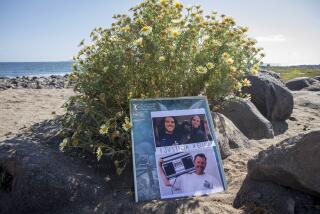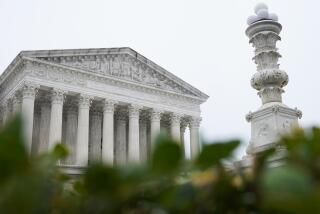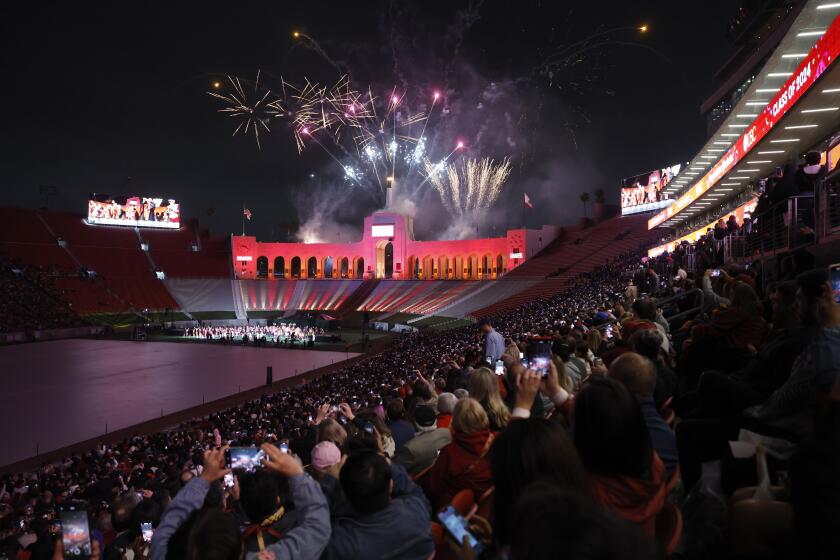Charting New Courses in Teaching About Columbus : History: Schools are taking a more critical approach, becoming entangled in difficult educational issues.
Nine-year-old Juan Carlos Osorio considers Christopher Columbus a hero for “discovering America” and displaying great courage. “If it was true the world was square, he would have died. He would have fallen off the ocean and into the sky,” the fourth-grader said.
On the other hand, he also knows that the famous explorer took American Indians as slaves and that they contracted devastating diseases from the crews of Columbus’ ships. “A lot of Indians got sick and died because he passed the infections to them,” the youngster disapprovingly told a recent visitor to his classroom at Leo Politi Elementary School in Los Angeles.
Not exactly the old schoolyard poem about Columbus sailing the ocean blue, is it? But this is no ordinary time for Columbus studies. As the world prepares to commemorate--or challenge the meaning of--the 500th anniversary of the Genoese sailor’s first of four trips to what he always thought was Asia, students across America are learning more ambivalent lessons about the man and his legacy.
The controversy over whether Columbus should be treated as a hero, a gold-crazed murderer or a neutral bearer of great historical change has entered popular culture through television shows, museum exhibitions and special editions of news magazines. Even this season’s Tournament of Roses Parade is involved, with an American Indian chosen as co-grand marshal to balance the earlier selection of a Spanish nobleman who is a descendant of Columbus.
Less flashy, but perhaps most important are debates in kindergartens and colleges over what teachers and textbooks should tell young people about Columbus and how his exploration affects life today.
Even the vocabulary is in flux: Were his landings on Caribbean islands a “discovery,” an “invasion” or, as is quickly becoming popular among teachers, an “encounter” that profoundly altered societies on both sides of the Atlantic?
Until recently, the scholarly debate was mainly at the university level, with interpretations as diverse as the wildly contrasting portraits of Columbus, which were all painted after his death in 1506 at the age of 55. Now it has begun to trickle down to elementary school classrooms, where the traditional lionization of the “Admiral of the Ocean Sea” is giving way to more critical treatment.
Along the way, teaching about Columbus has become entangled in such difficult educational issues as multiculturalism, political correctness, textbook revisions and academic freedom.
“The Columbus myth is a very key myth in America. It shapes the way people understand history. I think the Columbus myth functions as a secular book of Genesis,” said Bill Bigelow, a Portland high school instructor who is traveling around the country this year urging others to teach about the explorer in a way that highlights the disastrous effects that European colonization had on American Indians and their environment.
He is like a schoolyard missionary for the counterquincentennial views expressed in adult-oriented books such as Kirpatrick Sale’s “The Conquest of Paradise,” published last year. Some critics complained that such scathingly negative appraisals of Columbus impose today’s leftist notions of political correctness on a Renaissance explorer.
Bigelow spoke the other day to 50 teachers in Los Angeles at a meeting sponsored by the Human Rights Committee of the Los Angeles teachers union. His lecture included sharp critiques of textbooks that portray Columbus as a prototypical American hero--a persistent visionary with God on his side.
“The message is he was wise and brave and adventurous and so are we. It teaches children to pay attention to white male representatives and nobody else. It teaches children to think about the world in a way that is not very healthy,” said Bigelow, who also is an editor of a teachers’ manual called “Rethinking Columbus.”
Columbus never realized that he had not landed in Asia, and he wasn’t the first person to know that the Earth is round, traditional textbooks concede. But there is certainly no mention, Bigelow noted, of what right Columbus had to claim the land he found for Spain, enslave its people or have his men torture and execute them for not finding enough gold.
Many teachers in the audience were receptive to Bigelow’s revisionist view and said they would at least teach more about American Indian cultures and their destruction. A few others said they feared that too much negativity could confuse youngsters.
Yet almost all agreed that lessons about Columbus are particularly important to the enormous Latino populations in California schools. Many of these children have very little historical understanding of why their families speak Spanish or about how their backgrounds blend Spanish and American Indian ancestry, the teachers said.
Angel Barrett, who teaches gifted children in a bilingual Spanish-English elementary school in Los Angeles, said she views the 500th anniversary debate as a way to help develop their critical thinking skills.
“Learning about Columbus will be a way of looking at the European view, the Indian point of view and our view from 500 years later. It’s not so much who, what, when. We need more why, and if, and if not,” she said.
In an unusual action, the National Council for the Social Studies, a professional organization for history teachers that rarely takes a stand on details of course material, recently issued a policy statement on teaching about Columbus. “The voyage of Columbus is a much too significant event in human history for the nation’s schools and colleges to ignore or to treat romantically or trivially,” the council said.
It recommended that students be told that “the land that Columbus encountered was not a new world. Rather, it was a world of peoples with rich and complex histories dating back at least 15,000 years or possibly earlier.” The council urged that students learn that those people suffered “catastrophic mortality rates” as a result “of forces emanating from 1492.”
Moreover, instead of concentrating on the man Columbus, teachers should help students understand the “contemporary relevance of 1492” as the start of our multiethnic society, a global economy and the astonishing exchange of products, plants, animals and diseases across the Atlantic, the council stated.
That relevance is most clearly expressed in the current “Seeds of Change” exhibition at the Smithsonian Institution’s Museum of Natural History in Washington. The influential show has spawned books, teaching material and a special edition of Newsweek magazine.
The Smithsonian exhibition illustrates, among other things, how the introduction of corn and potatoes from America produced healthier populations in Europe and fueled the Industrial Revolution. The exhibit shows how the arrival of sugar cane in the Americas led to the plantation system and the slave trade from Africa, while the introduction of horses transformed American Indian cultures.
Some California teachers say that their lessons will give more emphasis to such exchanges. “These are the kinds of topics that are going to allow students to look at (Columbus’ 1492 voyage) not so much as one event but as a situation in time that triggered a lot of major changes worldwide,” said Diane Brooks, who oversees history programs for the California Department of Education.
Chuck Staneart, the history and social science consultant at the Orange County Department of Education, expects lessons about Columbus to launch classroom discussions about immigration and multicultural societies. “We want students to translate it into their own lives here in Southern California, where we are undergoing a cultural collision right now. Hopefully, we want to handle it better than the Spanish and Native Americans did,” he said.
Twenty-eight major educational organizations co-signed the National Council for the Social Studies statement, which was issued in October. Among them were the National Assn. of Elementary School Principals, the National Catholic Educational Assn., the National Education Assn. and the Organization of American Historians.
However, the American Federation of Teachers--which represents more than 750,000 instructors nationwide--refused to support it. Federation public affairs director Ellen Shearer contends that the Columbus statement is too politicized and makes no mention about how democracy is necessary for ethnic diversity to work.
“In the past, there have been some simplistic approaches to Columbus celebrations. Everything (from the voyages) was portrayed as good. We’re a little concerned that today’s political trends make it seem the consequences were all bad, when in fact the record would indicate that much bad and good was the result of the meeting of peoples and cultures,” Shearer said.
Likewise, Anne Paolucci, president of Columbus: Countdown 1992, a New York educational foundation involved in quincentennial events, said she feared that children would be taught “atrociously wrong” history tailored to “currently fashionable views of morality.”
Without ignoring the fact that the Spanish conquered the American Indians, youngsters should also be told that Columbus represents the “fearless Renaissance spirit” that created great art and scientific advances, said Paolucci, who also heads the English department at St. John’s University in Queens, N.Y.
Ironically, the debate comes at a time when Columbus seems to figure much less in children’s minds than he did a generation or two ago. California schools recently have increased the study of ancient and non-Western civilizations as well as of 20th-Century America; there is much less of an impression that all things emanated from Europe.
In California, Columbus is emphasized in the fifth and seventh grades. The new Houghton Mifflin social studies textbook series approved by California officials and used in many classrooms is less celebratory of Columbus than previous texts.
For example, the fifth-grade book presents Columbus as being bold, first in persistent wooing of Spanish royalty for a westward trip to Asia and then in sticking to his plan despite the threat of mutiny on his first voyage. It quotes a poem with the “brave admiral” urging “Sail on! Sail on! and on!” Yet, the book also presents his trips as a search for gold and valuable trade routes and as starting a Spanish expansion that “greatly reduced the number of Indians on these lands.”
The seventh-grade book also presents Columbus as courageous, and offers a dramatized version of the arguments he made in seeking support from Queen Isabella and King Ferdinand. It gives more details on his mistaken insistence that he had explored Asia when in fact he had reached the Bahamas, Cuba, Hispaniola--the island that includes Haiti and the Dominican Republic--and the South and Central American coasts. In a review section, the text asks students: “Do you think the harsh treatment of native peoples was a necessary result of European exploration?”
Wanda Burrell, who teaches seventh- and eighth-grade classes at the Vista View Elementary School in Fountain Valley, said the new state framework for history teaching encourages classroom discussion of controversial issues surrounding Columbus and other major figures. Burrell, who has been teaching for nearly 20 years, said she introduces more material about American Indians now than she might have in the 1970s. But she stressed that she never taught about “whether someone was a hero or not a hero,” preferring to show how Columbus may have been the right person at the right place and time. That contrasts sharply with her own elementary school education when, she recalled, “there was a sense of Columbus as the great hero responsible for everything.”
In recent interviews at elementary and high schools, some students were puzzled to learn that Columbus was to be the subject of major commemorations or controversy.
For instance, if he was such a big deal, why do many schools stay open on Columbus Day? asked Jenny Di Grado, a ninth-grader at Woodrow Wilson Junior High School in Glendale. She suggested, instead, a “Discovery Day” that would also honor “people who discovered medicines and technology.”
Wendy Ramirez, a fifth-grader at Leo Politi Elementary in Los Angeles, called Columbus a “half-hero, half not,” explaining that “he didn’t discover America because the Indians were already there.” Her classmate, Lizbeth Cobar, offered the view that Columbus “wanted to get the spices from India for the queen” and “just got mixed up” when he landed on Caribbean islands instead.
Herman J. Viola, the Smithsonian’s “Seeds of Change” curator, said he has been caught in the political crosscurrents, sometimes accused of being a Columbus-basher, other times as being too sympathetic. Most children and teachers, though, are hungry for a new way of looking at the man who sailed the ocean blue in 1492, Viola said, recalling that teachers often tell him: “Thank God, we are finally getting away from the Nina, Pinta and the Santa Maria.”
More to Read
Start your day right
Sign up for Essential California for news, features and recommendations from the L.A. Times and beyond in your inbox six days a week.
You may occasionally receive promotional content from the Los Angeles Times.






